
|

Bursting and expanding body (Image: Bursting and expanding body for static pipe bursting)
|
The bursting body only consists of the expanding body when working with brittle pipe materials. | | Roller knife (Image: Roller knife for static pipe bursting)
| + | Expanding body (Image: Bursting and expanding body for static pipe bursting)
| |
The bursting body additionally has a roller / cutting knife at the front when working with angular flexible and ductile pipe materials. |
|

|

The hydraulic bursting body consists of hydraulic expandable segments which take over the bursting of the pipeline and the suppressing of the pipe fractions or the expansion. Bursting body with 3 expandable segments (Image: Hydraulic pipe bursting - Bursting head with 3 expandable segments (closed)) (Image: Hydraulic pipe bursting - Bursting head with 3 expandable segments (opened)) Bursting body with 2 expandable segments (Video: Hydraulic pipe bursting) |
|

|

| The pneumatic bursting body normally consists of: | Expanding body (Image: Expanding head for pneumatic pipe bursting) | + | Pneumatic driving device (Image: Pneumatic bursting unit) | | An additional bursting casing can be added if required. (Image: Pneumatic pipe bursting unit with an auxiliary bursting cap and expander head in the rear; replacement with a HDPE continuous pipe from the insertion pit to the reception pit) |
|

|

|
Pipe bursting enables a replacement of all pipelines which are made of current materials (exception pre-stressed concrete) with the following damages: - Pipe breakage,
- Corrosion,
- Flow obstacles,
- Unprofessionally performed rehabilitation processes,
- Deformations,
- Cracks,
- Leakage,
- Mechanical wear.
| |
(Image: Collapse [FI-Jtele])
|
|
(Image: Lateral crack [FI-Jtele])
|
|
(Image: Corrosion in the invert area and longitudinal crack [FI-Jtele])
|
|
(Image: Longitudinal … |
|
|

|

| (Image: Attention!)
|
Application limits are affected by: - Piping – material, nominal size and condition
- Cover
- Geological circumstances in the replacement line
- Expanding dimension
- Effects on the environment
- Distances to crossway or longitudinal pipelines
- Number of branch connections
- Major positional deviation (displaced joints / under-bends)
- Groundwater
- Concrete beds and concrete partial / full surround
| |
(Image: Encasement and special supports of … |
|
|

|

| (Image: Pros and cons) | Advantages of pipe bursting: - Insertion independent of the material of the to be replaced pipeline (except for pre-stressed concrete, reinforced concrete with a high reinforcement).
- Multiple nominal pipe values can be covered with a bursting installation.
- Soil / ground operations drop out by usage of existing manhole constructions.
- Cross section enlargement of the to be replaced pipeline is possible.
- Rehabilitation lengths …
|
|

|

| (Image: Pros and cons) | Disadvantages of pipe bursting: - Application in groundwater without supporting measures are not or only conditionally possible.
- Possible damaging of the manholes during discharge of traction or shearing force. Therefore excavations have to be regulated concerning manholes with inadequate bearing strength.
- The soil in the embedment has to be displaceable and free of obstacles.
- Risk of damage of the product pipes during the positioning …
|
|

|

|

|

|
The pipe extraction - also called pushing/pulling process - is a method of the trenchless replacement of existing pipelines. A characteristic of this process catagory is the sector method of pulling-in the product pipes into the construction site with the aid of a hydraulic pulling-equipment situated in the target excavation with the simultaneous pushing-out of the pipe to be replaced . During this process, the pipeline to be replaced is completely … |
|

|

| (Image: Pipe extraction with splitter cone - Replacement of cast iron pipelines [FI-Weiss])
|
|

|

| (Image: Pipe extraction for the replacement of cast iron pipelines (Hydros System) [FI-Klug] - Adapter) (Image: Pipe extraction for the replacement of cast iron pipelines (Hydros System) [ATVA127a] - Splitter cone) |
|

|

Example: Pipe extraction process Hydros®-Plus |

|

| (Image: Attention!) Preconditions for the application of pipe extraction: - Circular pipe cross sections
- Preferably brittle pipe materials
- Displaceable soil in the embedment for cross-sectional enlargement
- Straight-lined section
| (Table: Pipe extraction - Possible materials of the old and new pipeline [FI-Steina]) |
|

|

|
The pipe extraction is used if the condition of the pipeline is marked as follows: - Leakiness;
- Lack of static load bearing capacity;
- Corrosion;
- Incrustations;
- Lead contaminations of potable water (lead pipelines);
- Enlargement of existing cross section.
| |
(Image: Steel potable water pipe with iron and manganese deposits [FI-Hermea])
|
|
(Image: Hole corrosion - pitting)
|
|
(Image: "Moving jet test " [Zimme01])
|
| | (Image: Attention!)
Precondition for the … |
|

|

| (Image: Pros and cons) | Advantages of pipe extraction compared to the open cut method: - reduction of road bed excavation and earthworks by 80%
- operation below obstacles (trees, lanterns, other pipelines etc.)
- minimisation of the disturbance of traffic and citizens
- minimisation of the movement of huge soil masses for the refilling of pipeline trenches
- low-noise, vibration-free and ecologically compatible operating method
- reduction of risk of accidents …
|
|

|

| (Image: Pros and cons) | Disadvantages of pipe extraction: - The pipeline to be replaced must be destroyed in the target excavation or in the intermediate excavations, while the pulling rods are still in the pipeline to be replaced.
- With incrustations, the insertion of the pulling rods may be problematic.
|
|

|

|

|

This lecture is part of the series "Trenchless 101" and serves to provide an overview of trenchless replacement methods for gas, water and wastewater pipelines. |
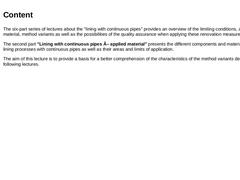
|

The six-part series of lectures about the "lining with continuous pipes" provides an overview of the limiting conditions, applied material, method variants as well as the possibilities of the quality assurance when applying these renovation measures. The second part "Lining with continuous pipes – applied material" presents the different components and materials used in lining processes with continuous pipes as well as their areas and limits of application. |
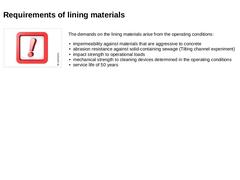
|

| (Image: Attention!)
|
The demands on the lining materials arise from the operating conditions: - impermeability against materials that are aggressive to concrete
- abrasion resistance against solid-containing sewage (Tilting channel experiment)
- impact strength to operational loads
- mechanical strength to cleaning devices determined in the operating conditions
- service life of 50 years
|
|
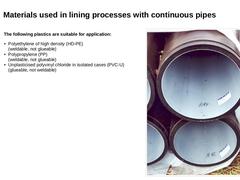
|

| (Image: HD-PE long pipes DA 500)
The following plastics are suitable for application: - Polyethylene of high density (HD-PE)
(weldable, not glueable)
- Polypropylene (PP)
(weldable, not glueable)
- Unplasticised polyvinyl chloride in isolated cases (PVC-U)
(glueable, not weldable)
|
|

|

|
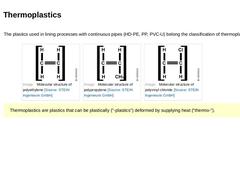
|

|
The plastics used in lining processes with continuous pipes (HD-PE, PP, PVC-U) belong the classification of thermoplastics. | |
(Image: Molecular structure of polyethylene)
|
(Image: Molecular structure of polypropylene)
|
(Image: Molecular structure of polyvinyl chloride)
|
| |
Thermoplastics are plastics that can be plastically ("-plastics") deformed by supplying heat ("thermo-"). |
|
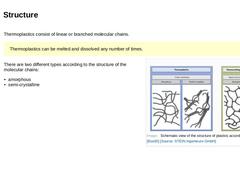
|

|
Thermoplastics consist of linear or branched molecular chains. | |
Thermoplastics can be melted and dissolved any number of times. | | |
There are two different types according to the structure of the molecular chains: - amorphous
- semi-crystalline
| (Image: Schematic view of the structure of plastics according to [Bos00] [Image: S&P GmbH])
|
|
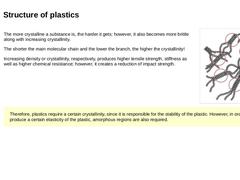
|

| (Image: Crystallinity of polyethylene according to [Bos00] [Jürge05])
The more crystalline a substance is, the harder it gets; however, it also becomes more brittle along with increasing crystallinity. The shorter the main molecular chain and the lower the branch, the higher the crystallinity! Increasing density or crystallinity, respectively, produces higher tensile strength, stiffness as well as higher chemical resistance; however, it creates a … |
|